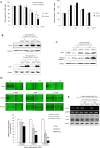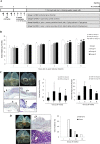Dietary prevention of Helicobacter pylori-associated gastric cancer with kimchi
- PMID: 26317548
- PMCID: PMC4745743
- DOI: 10.18632/oncotarget.4897
Dietary prevention of Helicobacter pylori-associated gastric cancer with kimchi
Abstract
To prove whether dietary intervention can prevent Helicobacter pylori-induced atrophic gastritis and gastric cancer, we developed cancer preventive kimchi (cpKimchi) through special recipe and administered to chronic H. pylori-initiated, high salt diet-promoted, gastric tumorigenesis mice model. H. pylori-infected C57BL/6 mice were administered with cpKimchi mixed in drinking water up to 36 weeks. Gross and pathological gastric lesions were evaluated after 24 and 36 weeks, respectively and explored underlying molecular changes to explain efficacies. Cancer preventive actions of anti-inflammation and anti-mutagenesis were compared between standard recipe kimchi (sKimchi) and special recipe cpKimchi in in vitro H. pylori-infected cell model. The erythematous and nodular changes, mucosal ulcerative and erosive lesions in the stomach were noted at 24th weeks, but cpKimchi administration significantly ameliorated. After 36th weeks, scattered nodular masses, some ulcers, and thin nodular gastric mucosa were noted in H. pylori-infected mice, whereas these gross lesions were significantly attenuated in cpKimchi group. On molecular analysis, significant expressions of COX-2 and IL-6, activated NF-κB and STAT3, increased apoptosis, and marked oxidative stresses were noted in H. pylori-infected group relevant to tumorigenesis, but these were all significantly attenuated in cpKimchi group. cpKimchi extracts imparted significant selective induction of apoptosis only in cancer cells, led to inhibition of H. pylori-induced proliferation, while no cytotoxicity through significant HO-1 induction in non-transformed gastric cells. In conclusion, daily dietary intake of cpKimchi can be an effective way either to rejuvenate H. pylori-atrophic gastritis or to prevent tumorigenesis supported with the concerted actions of anti-oxidative, anti-inflammatory, and anti-mutagenic mechanisms.
Keywords: Helicobacter pylori; anti-inflammation; anti-mutagenesis; cancer preventive kimchi; rejuvenation.
Conflict of interest statement
No conflicts of interest.
Figures





Similar articles
-
Fermented kimchi rejuvenated precancerous atrophic gastritis via mitigating Helicobacter pylori-associated endoplasmic reticulum and oxidative stress.J Clin Biochem Nutr. 2021 Sep;69(2):158-170. doi: 10.3164/jcbn.20-180. Epub 2021 Mar 27. J Clin Biochem Nutr. 2021. PMID: 34616108 Free PMC article.
-
Dietary Intervention of Artemisia and Green Tea Extracts to Rejuvenate Helicobacter pylori-Associated Chronic Atrophic Gastritis and to Prevent Tumorigenesis.Helicobacter. 2016 Feb;21(1):40-59. doi: 10.1111/hel.12229. Epub 2015 Apr 10. Helicobacter. 2016. PMID: 25864522
-
Resveratrol Protects against Helicobacter pylori-Associated Gastritis by Combating Oxidative Stress.Int J Mol Sci. 2015 Nov 20;16(11):27757-69. doi: 10.3390/ijms161126061. Int J Mol Sci. 2015. PMID: 26610474 Free PMC article.
-
Chemoprevention of Helicobacter pylori-associated gastric carcinogenesis in a mouse model: is it possible?J Biochem Mol Biol. 2003 Jan 31;36(1):82-94. doi: 10.5483/bmbrep.2003.36.1.082. J Biochem Mol Biol. 2003. PMID: 12542979 Review.
-
[Unpleasant Journey from Helicobacter pylori-associated Gastritis to Gastric Cancer: Cancer Prevention by Taking a Detour].Korean J Gastroenterol. 2015 Dec;66(6):303-11. doi: 10.4166/kjg.2015.66.6.303. Korean J Gastroenterol. 2015. PMID: 26691187 Review. Korean.
Cited by
-
Transcriptome profiling analysis of the response to walnut polyphenol extract in Helicobacter pylori-infected cells.J Clin Biochem Nutr. 2021 May;68(3):201-214. doi: 10.3164/jcbn.20-128. Epub 2021 Feb 5. J Clin Biochem Nutr. 2021. PMID: 34025022 Free PMC article.
-
Suppressed Helicobacter pylori-associated gastric tumorigenesis in Fat-1 transgenic mice producing endogenous ω-3 polyunsaturated fatty acids.Oncotarget. 2016 Oct 11;7(41):66606-66622. doi: 10.18632/oncotarget.11261. Oncotarget. 2016. PMID: 27528223 Free PMC article.
-
Fermented kimchi rejuvenated precancerous atrophic gastritis via mitigating Helicobacter pylori-associated endoplasmic reticulum and oxidative stress.J Clin Biochem Nutr. 2021 Sep;69(2):158-170. doi: 10.3164/jcbn.20-180. Epub 2021 Mar 27. J Clin Biochem Nutr. 2021. PMID: 34616108 Free PMC article.
-
Genetic variant of miR-146a rs2910164 C>G and gastric cancer susceptibility.Oncotarget. 2016 Jun 7;7(23):34316-21. doi: 10.18632/oncotarget.8814. Oncotarget. 2016. PMID: 27105532 Free PMC article.
-
Rejuvenation of Helicobacter pylori-Associated Atrophic Gastritis Through Concerted Actions of Placenta-Derived Mesenchymal Stem Cells Prevented Gastric Cancer.Front Pharmacol. 2021 Aug 18;12:675443. doi: 10.3389/fphar.2021.675443. eCollection 2021. Front Pharmacol. 2021. PMID: 34483897 Free PMC article.
References
-
- Machida-Montani A, Sasazuki S, Inoue M, Natsukawa S, Shaura K, Koizumi Y, Kasuga Y, Hanaoka T, Tsugane S. Association of Helicobacter pylori infection and environmental factors in non-cardia gastric cancer in Japan. Gastric cancer: official journal of the International Gastric Cancer Association and the Japanese Gastric Cancer Association. 2004;7:46–53. - PubMed
-
- Gonzalez CA, Jakszyn P, Pera G, Agudo A, Bingham S, Palli D, Ferrari P, Boeing H, del Giudice G, Plebani M, Carneiro F, Nesi G, Berrino F, Sacerdote C, Tumino R, Panico S, et al. Meat intake and risk of stomach and esophageal adenocarcinoma within the European Prospective Investigation Into Cancer and Nutrition (EPIC) Journal of the National Cancer Institute. 2006;98:345–354. - PubMed
-
- Park JM, Park SH, Hong KS, Han YM, Jang SH, Kim EH, Hahm KB. Special licorice extracts containing lowered glycyrrhizin and enhanced licochalcone a prevented Helicobacter pylori-initiated, salt diet-promoted gastric tumorigenesis. Helicobacter. 2014;19:221–236. - PubMed
-
- Kim HJ, Chang WK, Kim MK, Lee SS, Choi BY. Dietary factors and gastric cancer in Korea: a case-control study. International journal of cancer Journal international du cancer. 2002;97:531–535. - PubMed
Publication types
MeSH terms
Substances
LinkOut - more resources
Full Text Sources
Other Literature Sources
Medical
Research Materials
Miscellaneous

